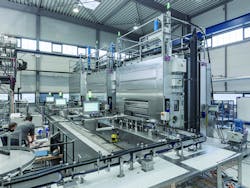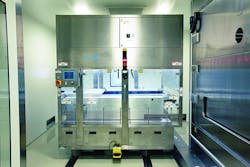An increasing number of active pharmaceutical ingredients produced using biotechnology are entering the market. These substances are generally extremely laborious and expensive to produce. Highly sensitive and with limited stability in liquid form, many of these drugs would be unusable within a few days. Although freeze-drying is often the only way to enable unstable drugs of this type to be marketed, new drug types are presenting new challenges.
Freeze-drying is a process whereby liquid medicines are protected against external influences such as light, oxygen or fluctuations in temperature. The process has been around for many years and is not used exclusively for medicinal items, with instant coffee probably the best-known widely freeze-dried product. But pharmaceutical freeze-drying presents particular challenges with regard to the process and the technical equipment used.
Freeze-drying removes the solvent (usually water) from the liquid drug, leaving behind a cake of active ingredient — also known as lyophilisate — in the container. This powder contains the pharmaceutical active ingredient. Then, the lyophilisate is only mixed with pharmaceutical water again when the drug needs to be administered. Lyophilisates generally dissolve very well, with the drug retaining its original properties.
The procedure: A process within a process
Pharmaceutical freeze-drying is a complex, time-consuming procedure, which can be usefully integrated into the filling and closing process. Both freeze-drying and packaging must be coordinated to one another during project planning in considerations from mechanical connections and containment to control technology.
The processing path typically includes the following (automated) processing steps:
- The liquid drug is measured into containers, usually vials.
- Special freeze-drying stoppers are placed in the vials, though not fully pushed-in; these stoppers have recesses on the sides, via which water vapor escapes during the freeze-drying process.
- The vials are transferred to the freeze-dryer loading unit.
- The loading units arrange the vials into a specific formation, in hexagons for example. The vials are transferred onto the shelves of the freeze-dryer. Alternatively, the freeze-dryer or shelves may be loaded with vials one row at a time. Freeze-dryers contain up to 15 shelves, which are vertically adjustable so that multiple "levels" can be used in the freeze-dryer.
- The actual freeze-drying process consists of multiple phases (further details below).
- Once the freeze-drying process is complete, the vials are also closed in the freeze-dryer: Movable shelves push the freeze-drying stoppers fully into the vials.
- The vials are then automatically removed from the shelves, and simultaneously transferred back to linear processing.
- Crimp caps are added to the vials.
- The crimp caps are then crimped closed. Only at this point are the containers considered sealed in accordance with the regulatory requirements.
- With highly active drugs or where specific requirements apply, the outsides of the vials are washed.
The pharmaceutical integrity of the drug being processed requires continuous containment using cRABS or isolators, for example, through steps 1–4 and 6–9. Aseptic conditions are also created inside the freeze-dryers, using automated, qualifiable decontamination processes, and the freeze-dryers themselves have extremely low leak rates. This means that filling and sealing together with freeze-drying forms a continuous, aseptic process chain that is protected against external influences.
Assembly of a system with three drying chambers: The floors can be opened and closed as required in the production hall specifically designed for freeze-dryers.
Various stages of a lyophilisate in a vial: The freeze-drying process is embedded into the filling and sealing process.
Compression refrigeration machine for the shelf circulation circuit. Four refrigeration modules are positioned on the left. On the right are two circulation pumps for the circulation circuit, one of which is designed to be redundant.
Freeze-drying: Ice sublimates to steam
Freeze-drying is divided into three steps: Freezing, primary drying and secondary drying. After loading, the vials are positioned on the shelves of the drying chamber. The inner structure of the shelves takes the form of channels, into which a tempering fluid (usually silicone oil) flows. Depending on the process step, energy can be either removed from or added to the product by means of the tempering fluid.
During the freezing phase, the drug is cooled, frozen and then supercooled in the vials. The next phase involves the targeted use of sublimation, whereby the liquid physical state is left out through application of a defined vacuum: The ice is transformed directly into vapor. The benefit of this is that the solution vaporizes at low temperatures, and so the drug is not subjected to thermal stress.
The vapor that forms is diverted from the drying chamber and frozen in the neighboring condenser. An intermediate valve connects the drying chamber and condensing container to enable this. From this point, the temperature of the shelves is continually increased, but without thawing the frozen drug. This primary drying process is followed by the secondary drying stage. The active ingredient "cake," or lyophilisate, remains in the vials. At the end of the process, the ice in the condenser is thawed. The entire freeze-drying process takes between a few hours and several days per lot/batch.
System design and components
A freeze-drying system consists of the following main components: drying chamber (with shelves), condenser container (with a heat exchanger, the condenser), intermediate valve, refrigeration system and vacuum system.
The refrigeration system provides the required low temperatures for the shelves and the condenser. The purpose of the condenser is to collect the water vapor produced as a result of sublimation, which freezes on the refrigeration coils of the condenser.
The vacuum system provides the defined negative pressure in the drying chamber that is required for a liquid drug to undergo sublimation. Finally, there is an intermediate valve between the drying chamber and the condenser that can be closed for the freezing process and is then opened for the drying process so that water vapor can escape.
Freeze-drying systems identify a product value for each batch; this may be several millions in U.S. dollars, and in many cases is greater than the value of the freeze-dryer itself, which may be a large system loaded with more than 150,000 vials in which expensive biopharmaceutical drugs are freeze-dried. These high values must be taken into account in the system design.
Redundancy results in additional reliability: Freeze-drying systems are mostly equipped with a backup, for example in the case of the industrial PCs that are used for system control, or in respect to the vacuum pumps, refrigeration systems and measurement instruments such as the temperature and pressure sensors. So, if one of the duplicated system components fails, the batch is not lost, as the second PC or second pump, etc., then takes on the required function.
New challenges
Pharmaceutical freeze-drying is a tried and tested procedure. That said, it has encountered new challenges. Currently, the specific challenges facing freeze-drying lie in minimizing energy use, and the handling of new types of biotechnological drugs.
Using as little energy as possible
Pharmaceutical freeze-drying is considered to be very energy-intensive. Implementing a variety of approaches should reduce the amount of energy required.
The first step on this path is always ensuring a freeze-drying system and the diverse associated process parameters are adapted, as far as possible, to the customer’s actual needs. Different design variants arise based on the planned-use scenarios, drugs to be processed, etc. The sum of a specific system’s details can also result in significant energy savings. A selection of these design options is described below.
Many variants of refrigeration systems are available. Refrigerants such as LN2 — as well as combined systems that cover load peaks using the LN2 refrigerant — may offer an alternative to "traditional" refrigerant systems that use compression machines. This reduces energy usage; however, the costs of investment and operation are higher.
The efficiency of refrigeration systems themselves has been continually increasing over recent years. One interesting method is to use compressor overrun for cooling at another point: Cascade refrigeration systems use this mechanism with multiple compressors connected in sequence.
Where multiple freeze-drying systems need to be operated, a centralized refrigeration system may prove more useful than several decentralized ones in terms of the energy balance. Similarly, clever usage planning of the various systems can contribute to consistent cooling performance, which has a positive effect on energy consumption.
Shelf design significantly influences freeze-drying processes and energy use, as it is important for their effective area to be completely evenly convection-cooled where possible. In addition, the absolute flatness of the large surfaces is crucial for optimum use of the energy consumed. Optimized ice condenser refrigeration coils should be used for the different refrigeration concepts in each case to also achieve energy savings here.
The system builder will consider these and a few additional measures to achieve operation that is as resource-efficient as possible for the operator.
One loading system for several freeze-dryers. Unloading takes place at the back of the freeze-dryer.
Shining a light into the "black box"
The pharmaceutical freeze-drying process is sometimes known as the "black box." It is considered to be a stochastic process, meaning that even today various results parameters cannot be 100 percent controlled. So while it is possible to fully preserve product integrity and achieve storage suitability for a drug as required, a certain "buffer" needs to be calculated into the process for other parameters, such as residual moisture and drying time, to accommodate deviations from the statistical average in terms of lyophilisate behavior. The challenge is in more precisely controlling the process overall than has previously been possible.
New approaches such as vacuum-induced freezing have contributed to significant improvements, in particular in terms of optimizing the quality of the freeze-dried drug, in which respect it is primarily the optimized residual moisture and homogeneity of the powder that is of interest. This process can also have a positive impact on duration of the freeze-drying process in some cases — and a shorter process ultimately also has a similarly positive impact on energy use.
Highly potent drugs: Averting risks
As mentioned, new types of active ingredient result in different "signs" in pharmaceutical freeze-drying. Many of the newest biopharmaceutically produced drugs are complex and sensitive, often with a specialized effect that targets, for example, only individual, certain types of cancer. They are mostly only produced in small batches. Often, not only are these types of active ingredient generally expensive, but also extremely potent in effect. As such, even small quantities represent a potential health risk to machine operators, and it is necessary to fully eliminate this risk in the freeze-drying area and connected systems.
Many factors need to be considered when designing systems for highly potent active ingredients. And, where these are integrated into the packaging process, everything pivots on interfaces: Any points at which the filled containers are taken over into the loading systems and freeze-dryers need to be perfectly attuned to one another. There must be no mechanical hurdles to transport, as cracked or tipping vials result in unnecessary risks for operators and long interruptions to production.
In the same way, consistent, coordinated containment must be in place, for example, by using isolators. Connections between the transport and loading system as well as the transition into the freeze-dryer must also be taken into account here. The same applies when products leave the freeze-dryer, up to the point when the vials are fully sealed (crimped closed).
It is undoubtedly an advantage if, at containment design stage, the freeze-dryer loading and unloading systems and the isolator system are already coordinated to one another in terms of their construction, where possible, and tested. Cross-subsection simulations have proven helpful in this regard; turnkey manufacturers that cover all subsections offer the ideal prerequisites for these.
Inside freeze-dryers, clean-in-place and sterilize-in-place systems have become generally established for decontamination in aseptic applications. Automated systems can also be qualified and validated. It must be noted that the design must not permit the accumulation of liquid residue at any location inside the freeze-dryer, and particular attention must also be given to vacuum pumps, with a view to avoiding cross-contamination.
A very different safety feature is the monitoring and evaluation of freeze-drying processes using data. Supervisory control and data acquisition (SCADA) systems are widely established today and can be used to determine the cost-efficiency of freeze-drying systems, while process analytical technology (PAT) additionally enables monitoring of processes’ technical and physical parameters. Temperature and pressure sensors are virtually standard in freeze-drying systems, as they are used to monitor processes. Various enhanced PAT tools are useful here, including, for example, mass spectrometers or tunable laser absorption spectrometers (TDLAS) as well as various vacuum sensors (Pirani and capacity vacuum sensors).
Enhancing system flexibility
Freeze-drying for major campaigns such as vaccination programs is different from freeze-drying for small batches, in more ways than just the size of the shelves — the structure of the system may also be very different. For example, in large freeze-drying systems the condensers and additional technology are often placed on a service floor, with only the drying chamber located in a clean room; in smaller systems, these system components mostly need to be physically separated in another way.
For freeze-drying system manufacturers, the challenge is in designing smaller systems to be as flexible and compact in structure as possible, in order to be equipped for a wide variety of requirements. They should also be easy to integrate into existing production environments. A modular structure helps to meet these demands. Another factor to consider is that connected filling and sealing systems can be used in parallel to running freeze-drying processes, provided that this capability is taken into account at an early stage in the system design process.
The targeted scaling-up from laboratory level to production is also seeing greater importance with new drug types — simply because scaling-up needs to be performed more frequently. Ensuring as targeted an approach as possible is important here, and in light of that, new models have been developed that enable the precise transition of processes from the laboratory into production. This results in formulations that are efficient from the outset, and at the same time that safeguard pharmaceutical integrity.
Summary and outlook
Freeze-drying continues to be essential in the pharmaceutical industry. For many drugs, particularly those of the biopharmaceutical type, it is often the only means by which to achieve an appropriate storage life. A lot of work has gone into developing procedures that are as reliable and cost-efficient as possible — including specific efforts aimed at meeting the many new requirements associated with biopharmaceutical drugs.
As this freeze-drying is a complex process, a group made up of parties from across research and industry convened in 2014 to work on the future of freeze-drying, taking an overarching perspective as it focuses on questions relating to industrial applications (Lyohub.org). With this diverse range of development approaches, freeze-drying technology will continue to be a solution that fully takes into account the needs of the pharmaceutical industry into the future as well.
Dena Flamm is a Business Development Manager for OPTIMA Machinery Corporation. She is responsible for freeze-dryer development in the North American market and has more than 17 years of experience in the pharmaceutical industry.
Stephan Reuter has been Managing Director of OPTIMA pharma GmbH at Gladenbach-Mornshausen near Marburg, Germany since January 2014. He previously held management positions at pharmaceutical companies and international engineering firms.





